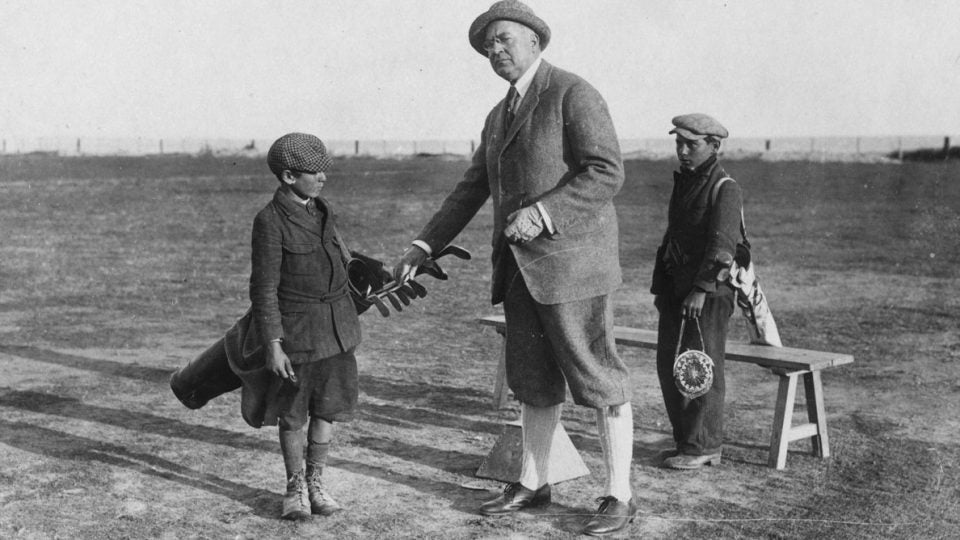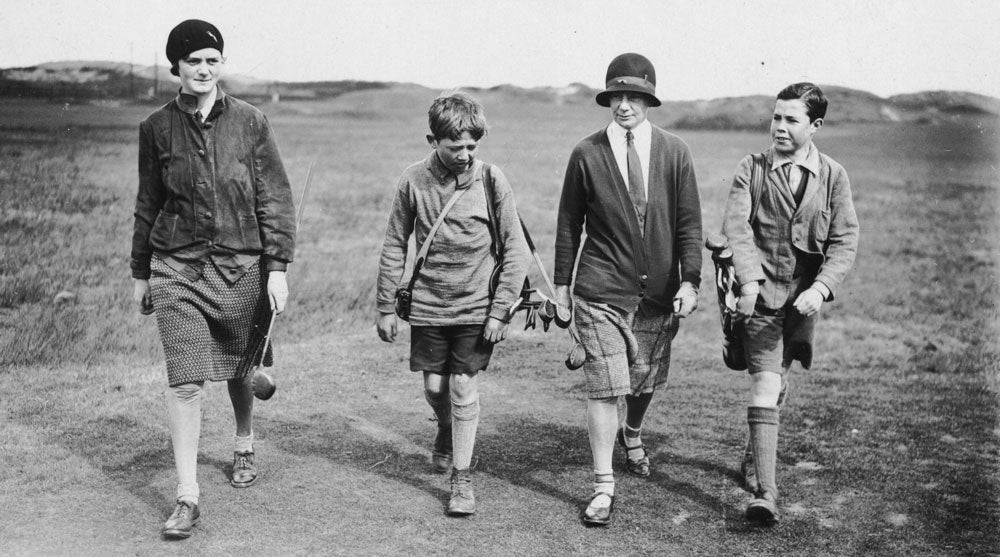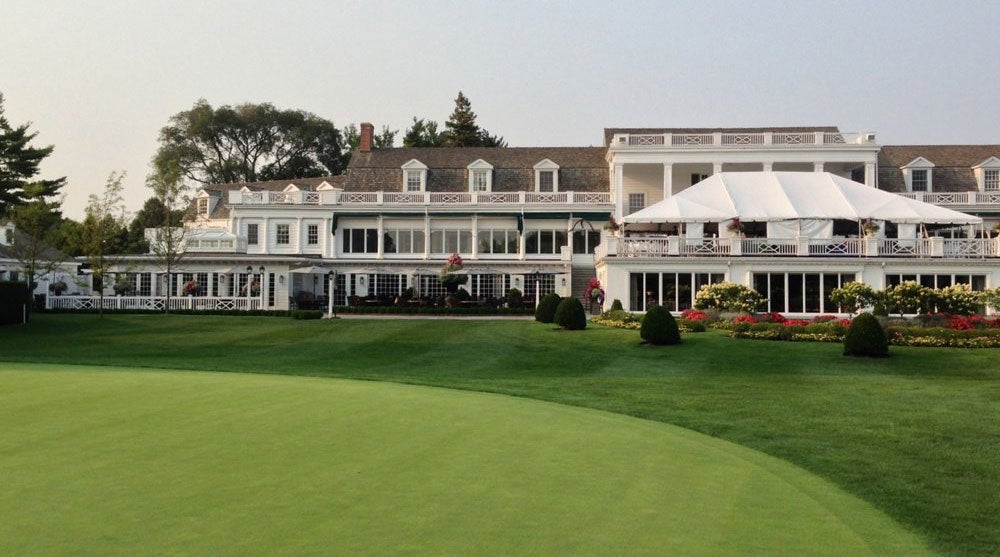
A century ago, cheating was common at America’s golf clubs, fueled by the compliance of child caddies
On Dec. 3, award-winning author Julie Fenster published her latest book, Cheaters Always Win: The Story of America, a social history of cheating and how American society has bent the rules to its own gain, including on the golf course. Excerpted below is Fenster’s exploration of the cheating epidemic at U.S. golf clubs in the early 20th century, and the young caddies who were complicit in the practice. You can buy the book here.
*****
At the Westmoreland Country Club, a fashionable course near Chicago, the caddies of the early 1920s had seen it all, despite the fact that they weren’t yet adults. In fact, they weren’t teenagers, either. They weren’t even youths. Most were 10 or 11 years old.
While a modicum of child labor has merit, work being intriguing to youngsters, it’s hard to picture the grown man who felt comfortable letting a 10-year-old lug his golf bag. And if such a man did exist, in endless foursomes just outside of Wilmette, it is even harder to imagine him placing his faith in the caddie’s opinion of the ball’s lie, with an added tip on the moisture content of the green and a reminder to choke up on the niblick for a chance at par. Caddying, however, was not particularly well-paid work. Westmoreland, try as it might, had trouble recruiting anyone at all to carry the clubs, let alone the robust Scotsmen it no doubt would have preferred. As it was, wee bairns caddied for a nominal wage and the hope of tips.
The caddies at Westmoreland may have been a gang of little guys, but they needed no Fagin to teach them. They knew the ethics of golf.

The game had arrived in America and specifically in Chicago only a generation before. With the addition of betting on friendly games, golf then took its place as the preferred way to make fresh air tolerable and exercise bearable. Cheating also became a part of a good day on the links. The old Brooklyn Eagle, a forthright newspaper if ever there was one, saw nothing wrong with cheating in golf and what is more, nothing remarkable about expecting the caddie to be complicit. When a caddie, noted the paper, “is the only spectator of what goes on in a trap, he does not publish his knowledge to the world. When the golfer having finally holed out turns to him and inquires: ‘What did I make, caddie? Five or six?’ the caddie knows enough to say ‘five.'”
Needless to say, if something goes on in a trap that is worth publishing to the world, the correct answer would be more like “12.” If not more. Everybody on the other side of the berm suspects that the golfer (the one with only one small spectator in the trap) had six hacks in the sand alone. But such a calculation is only something one thinks on the golf course. One doesn’t say it. Certainly not if one is a caddie. The caddie, explained the Eagle, “always gives the golfer the benefit of the doubt.”
That presumption ended with a jolt at the Westmoreland Country Club in August 1922. William P. Kent, an officer at a large insurance company, was incensed. “Caddies have been a nuisance on the golf course,” he said. “They accuse members of cheating in their scores and if the members don’t come across with a five-dollar bill, they threaten to report.”
It was true. “Cough up $5 or I’ll tell your real score,” became the caddie mantra at the club. The boys had been engaged, after all, to take part in the game of golf, not to kick balls out of the rough. Not to watch in silence as their temporary boss stepped on a ball hit badly and then walked closer to the green to drop a new ball from a hole in his pocket. Some players mixed golf with soccer, kicking the ball for distance or toeing it gently to a better lie. They became dexterous with a putter — not to stroke the ball, but to flip their marker closer to the hole. It isn’t exactly golf, but a related game. When a player perfects it for the sake of ego or a steep return on a bet, the caddie who makes it all possible naturally wants to share in the victory.

Kent was part of a cadre of aggressive businessmen who had left the dominant New York Insurance Company a few years before to form the North American Insurance Company, startling the conservative industry with a charter that gave them concentrated powers of governance. Kent, the secretary/treasurer, was at the hub of the successful company that resulted. He was accustomed to starting battles and winning them — until he met Charlie Bruckhauser.
“[In] the play of the club championship on Aug. 15,” Kent reported, “I had a caddy named Charles Bruckhauser. I believe he is eleven years old. We got along without trouble until the last hole.”
After the “trouble,” Charlie was called before the country club’s board of governors. His testimony was secret, but according to reports, he testified that at the end of the round, he made mention of “irregularities” in Mr. Kent’s play.
“The boy,” Kent said, picking up the story, “demanded that I give him a tip of $5. He said that should I refuse he’d report that I had been cheating. ‘If you do, you’re a damned liar,’ I told him.”
According to Charlie, it was at that point that Kent responded “by choking and beating me.”
“If he says I touched him,” Kent said, “he’s not telling the truth.”
READ MORE: 13 WAYS TO CHEAT AT GOLF AND HOW GUILTY YOU SHOULD FEEL ABOUT THEM
The board investigated for two weeks. The standoff at the swank country club was national news. Charlie held his ground. So did William Kent, but ultimately, he was judged to have slapped Charlie out of frustration. The penalty was suspension from the club — a calamitous reproach. He never recovered his reputation and in a decision that may have been related, he moved out of Illinois within a year. Charlie, meanwhile, was likewise banished from Westmoreland, without a reason cited. Extortion may have been one of the charges; it’s a cruel form of commerce, even though its use by an 11-year-old only burnishes the image of greater Chicago in the 1920s. The boy had tripped, however purposely, on the fact that cheating was accommodated within the universe of weekend golf.
More recently, a player from Galveston, Texas, commented on that lurking reality. “The vast majority of golfers are strictly honest. The one or two percent of cheaters stand out like a wart on a beauty’s chin,” he railed. “Do I cheat at golf? Of course not. The only time I do is when I am almost sure that I won’t be caught.”
In respect to the phenomenon, the Westmoreland Country Club was not unusual, except as the venue for one of the most vivid confrontations in American history: Kent v. Bruckhauser. One was brawny, rich, and practiced in the ways of the world. The other was a scrawny urchin with a bemused look in his eye: a disparate match-up, even in sporting America. Charlie was 11 when he laid waste to Kent. It was the power that glows around cheating that brought Kent down, after the kid had succeeded in swiping it away from him.
Excerpted from Cheaters Always Win: The Story of America by J.M. Fenster. Copyright 2019. Available from Twelve, an imprint of Hachette Book Group, Inc.
ADVERTISEMENT

